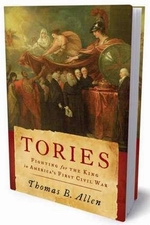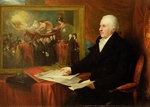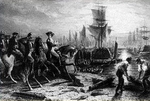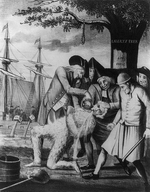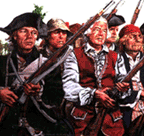|
Fighters
for the King
Loyalists
fought in more than 150 military units that were raised during the
Revolutionary War. In the South alone, British military archives list
26 units that fought during southern campaigns.
Most
British Army regiments had long, well-documented, and respected
histories. Loyalist units, however, came and went, dissolving or
merging over the course of the war—and leaving scant records
behind. When the war ended, the British Army would live on,
while the Loyalist Provincial Corps, as the British called the Tory
units, would fade away.
The
following introduction to these nearly forgotten Loyalist military
units was contributed by Todd W. Braisted, director of the On-Line
Institute for Advanced Loyalist Studies (see
http://www.royalprovincial.com/index.htm ) and a longtime
authority on the Provincial Corps. The On-Line
Institute was a major source for the unit descriptions, which were
written by Roger MacBride Allen and his father, Thomas B. Allen, the
author of Tories.
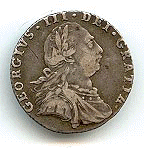
King George III
The
Loyalist equivalent of the Continental Army was referred to as the
Provincial Corps. Raised under the auspices of the commander in chief
of the British Army, in all theaters of the conflict, these troops
were enlisted for the duration of the war and liable for service
anywhere in North America. They received the same pay, provisions,
quality of clothing, arms, equipage, and accoutrements as British
soldiers, while serving under the same discipline. Some units were
short-lived and some served for the whole war.
Numerous
British officers and sergeants were sprinkled throughout these units
to help bring them up to a state of tactical proficiency and
professionalism. Provincial units were primarily used in limited
roles early in the war, but as the number of British units dwindled
in America, the value of the Provincial units increased, taking a
leading part, particularly in the South. When units became
significantly under-strength, with little prospect of recruiting
anew, members of those units were generally drafted into other
regiments.
Five
Provincial regiments received the special status of being placed on
what the British Army called the “American Establishment.”This
was considered an honor, given to units that had achieved their
recruiting goals or performed particularly well in battle. Not
coincidentally, current or former British officers commanded four of
these five units. Seven Provincial units, including three on the
American Establishment, achieved the highest recognition by being
placed upon the Regular Establishment.
Some
Loyalist units were raised by order of the governor of a province, if
the British government functioned there. These were standing corps,
paid for and supplied through the governor’s budget. These
units were not a part of the army per se, and did not enjoy the same
benefits of Provincial troops. Most served only a limited time and
all were disbanded before the end of the war. Such units included
the West Florida Provincials, the East Florida Rangers, and
the Ethiopian Regiment. These were the equivalent of the
so-called State Troops raised from time to time by the states.
Militia
laws were either in place or passed wherever the Crown held sway.
Under these laws, the militia generally consisted of all able-bodied
males between the ages of sixteen and sixty, usually with exemptions
for Quakers, firemen, and the civil authorities. These units were
typically raised along county lines and only served when needed. Some
of these militia corps were volunteers, while others were compulsory.
The volunteer units were often uniformed, while the other corps
mostly provided their own arms, ammunition, equipage, and clothing.
Militia
men on active service generally drew British provisions—and
sometimes British Army pay. This confirmed the rank of officers in
the army as well as guaranteed them half-pay upon retirement, known
in the British Army as “reduction.”
The
militias primarily acted on the orders of a province’s
governor, as in Georgia, Nova Scotia, and New York. British military
commanders took a much more active role in directing the activities
of militias in the Carolinas.
The least structured
units tended to be those under the appellation of “Associators”
or “Refugees.” These tended to be separate and distinct
from the army, tailoring their operations to achieve self-interests
or financial gains. One of them, the Associated Loyalists,
operated under a charter from the king himself. The Loyal
Associated Refugees not only lived by “interrupting
commerce” as privateers but also by contracting to perform such
work as collecting wood from inhabitants of Martha’s Vineyard.
These units received minimal support from the British, and their
near-autonomy was a source of some friction with different British
commanders.
The
following military units described here were more or less raised
through official means and were regularly supplied with men.
Temporary formations were often created as the exigency of the
situation required, such as temporary militia companies formed at
Savannah and Yorktown during their respective sieges. Militia units
were likewise occasionally formed by local army commanders in Georgia
and the Carolinas, and these units sometimes quickly passed into
history. The militias throughout the Province of Quebec were more
regularly organized, but they had scant active military roles.
A
large number of Loyalists served in both the Civil Branches of the
Army and Artillery. These organizations were the support services of
the military, employing wagoners, laborers, and skilled mechanics.
Thousands served in their ranks, in all theaters of the war.
A
few Loyalists, such as Oliver DeLancey, Jr., and Arent Schuyler
DePeyster, were officers or enlisted soldiers in Regular British
regiments. More served in the Royal Navy, some by voluntary
enlistment, others the results of impressment. Thousands
additionally took to the seas in privately owned and armed warships,
known as letters of marque or privateers. These ships, usually built
for speed over heavy firepower, were engaged in attacks on enemy
commerce, with the prize vessels and cargoes sold for the benefit of
both the owners and crew.
Loyalists
willing to risk their lives served as spies, army guides, or ship
pilots. The Indian Department employed many Loyalists and
occasionally had in it such units as Brant’s Volunteers
or the Loyal Foresters.
One
of the most distinguished and prominent Loyalist units, made up
mostly of New Yorkers, was the King’s American Regiment,
led by Colonel Edmund Fanning. The regiment served in six major
campaigns across the length of the eastern seaboard. The officers and
men fought in some of the bloodiest battles of the war, ending their
service by being placed on the regular British Establishment, an
honor bestowed on but a handful of Loyalist units.
–Todd
Braisted
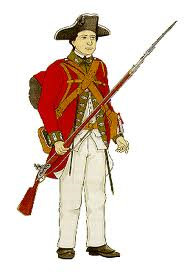 
Private (left) and
officer in the King’s American Regiment
Loyalist
Collection, University of New Brunswick, Canada
The Armed Loyalists
These
descriptions of Loyalist military units in many ways reflect the
complicated history of the units themselves. Records are spotty,
primarily because the British Army, a great keeper of records, did
not regard their Loyalist comrades as equals. The Crown did not award
battle honors to British regiments that fought in America because the
British saw the Revolution as a civil war. (Battle honors were,
however, awarded for actions against America’s French and
Spanish allies in the West Indies and other theatres.)
More than 1,500 Americans became Loyalist officers. Their success at
recruiting produced unexpected results. Regular British Army
officers, whose commissions almost inevitably stemmed from wealth and
family connections, resented the Loyalist officers’ easily
acquired commissions and promotions.
The better the Loyalist officers were at talking and promising, the
quicker they formed regiments and the faster came their captaincies
and colonelcies. Regiments were formed not on the basis of military
wisdom or experience but also on the ability of recruiters to get men
to sign up for specific periods of time. Regulars, as professional
officers, kept track of their careers, not their calendars.
A
number of units came and went. They usually consisted of twenty or
even fewer men who were assigned to garrison duty, police patrols,
digging fortifications, cutting wood, guarding woodcutting parties,
and other routine duties. They left behind little record of what they
had done. Many of these smaller units were eventually merged into
larger units, often were called “Independent Corps” or
“Independent Companies.” But many smaller units did see
significant combat and fought valiantly.
Adding
to the confusion, many units were known by more than one name–or
even two or three similar names. A unit’s name was not always a
reliable guide to where the unit was raised. For example, the Jamaica
Corps was raised in New York and Charleston. Many units were raised
in one locale and transported to another. The Maryland Loyalists, for
example, fought in Florida, were all taken prisoner and shipped to
Cuba (a possession of Spain, which had joined France as an American
ally). From Cuba, the Marylanders went to New York. At the end of
war, while sailing for Canada, most of them died in a shipwreck.
Several
units recruited free blacks and escaped slaves who were offered their
freedom in exchange for serving the Loyalist cause. Officers of such
units were white, but the ranks of some included whites. These units
did some fighting, but more typically served as “Pioneers,”
a term that in this context means doing the digging, cleaning, and
other less glamorous military tasks.
Many
reports describe the drafting of one unit into another. In effect,
this meant that the unit was disbanded, with its soldiers and
officers being placed in the receiving unit. A unit might even be
drafted into two or more receiving units. This might happen if morale
had collapsed in a unit, if the unit had simply lost too many men to
disease, war wounds, and desertion, or if, from an administrative
point of view, the unit was simply too small to bother with.
Little
can be found about some units, but sometimes information about
someone connected to the unit can illustrate some aspect of
American-versus-American warfare. Units for which little is known
except the unit names and commanders, and those not
known to be involved in military actions connected to the American
Revolution have been included in the list for the sake of
completeness, and for the convenient reference of future researchers.
They are listed separately.
–Roger MacBride Allen and Thomas B. Allen
----
Adams Company of Rangers
An independent company raised for the
British Army, this unit was founded by Samuel Adams, who lived in
what is now Arlington, Vermont. Rebels once hoisted Adams, in an
armchair, twenty-five feet to place him next to a stuffed catamount
on a tavern sign pole in Bennington. Most of the unit’s 70 men
came from the New Hampshire Grants, the long-disputed territory that
became Vermont. The men worked as guides, carried messages between
commanders, and stole cattle from Rebel farms during General
Burgoyne’s invasion of New York. After the defeat of Burgoyne
at Saratoga, Adams fled to Canada, a flight probably also taken by
his men, who faced Rebel retaliation if they returned home.
American Legion
Raised by Benedict
Arnold, the Legion included many deserters from the Continental Army.
In December 1780, the Legion, along with Hessians and British regular
troops, invaded Virginia by sea, raiding, burning, and looting
Richmond and wrecking a cannon foundry. The Legion raided the area
again in spring 1781 and in September 1781 attacked New London,
Connecticut, and nearby Fort Griswold. One of 212 men in the unit was
a Patriot mole whose never-accomplished goal was to kidnap Arnold and
bring him through the lines to be hanged as a traitor.
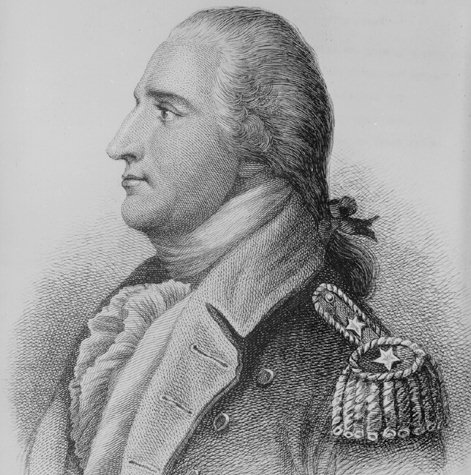
Benedict Arnold in the uniform of a
Continental Army major general.
Drawn
by Pierre Du Simitiere, New-York Historical Society.
American
Volunteers (also known as Ferguson’s Provincials)
were Loyalists trained, fed, and paid as if they were in the regular
British Army. The unit was initially formed of
175 New York Tories who
served as riflemen and rangers under Lieutenant
Colonel Patrick Ferguson of the British Army. Active in
the siege of Charleston, they also fought at Monck’s Corner,
South Carolina. While serving in the South, the Provincials helped to
train other Loyalist regiments. The Volunteers formed the core of the
1,000-man force that was nearly wiped out in the battle of King’s
Mountain on October 7, 1780.
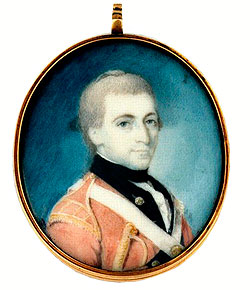
Patrick Ferguson
Anonymous
miniature, c. 1774-77, from a private collection
Armed Boat Company
Authorized by General Sir Henry Clinton
in July 1781, this seagoing unit manned armed whaleboats (narrow
vessels about thirty-six feet long, with pointed bows and sterns,
sometimes armed with small cannon). Several members of the unit were
former slaves. Among the unit’s combat operations were attacks
on Rebel whaleboats in New Brunswick, New Jersey, in January 1782 and
an attack on a Rebel blockhouse at Tom’s River, New Jersey, in
March 1782. The company’s first commander, William Luce, was
almost immediately captured by the Rebels. His successor, Edward
Vaughn Dongen, enlisted more than 125 men, mostly from Essex County.
Artificer and
Labourer Volunteers
One of three units
raised by Captain Robert Pringle, an officer in the Royal Corps of
Engineers. He was in charge of constructing new defenses in the
harbor of St. John’s, Newfoundland, when the war began. This
unit was about 120 strong. See Newfoundland Regiment.
Associated Loyalists
A ferocious Tory
guerrilla organization, it was overseen by a Board of Directors that
included its founder and real commander, William Franklin, last Royal
Governor of New Jersey and son of Benjamin Franklin. The Associates
staged raids across Long Island Sound to Connecticut and were
involved in the notorious hanging of a New Jersey Rebel, Captain
Joshua Huddy. Franklin also raised the King’s Militia
Volunteers, whose chores included cutting wood for the British Army.
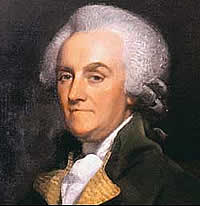
William Franklin
Detail
of 1790 portrait by Mather Brown
Bagaduce
Regiment
Before the Revolution
began, Thomas Goldthwait, a Boston merchant, served as Secretary of
War for Massachusetts Bay. He was also commander of Fort Pownall,
built in 1760 at the mouth of the Penobscot River (now in Maine, then
part of Massachusetts). When British
forces seized the fort’s cannons and powder in 1775, Goldthwait
was branded a traitor. As an admitted Tory, he formed and commanded
the Bagadue Regiment, named after a town later named Castine. He
later fled to British-occupied New York City on a Royal Navy warship
and eventually sailed to England, where he died in 1799. The
so-called regiment apparently was one of two battalions (the other
being from Boston) that combined to form the Massachusetts Militia.
Barbadian Rangers
Raised in Barbados from
July 1781 and intended for service in the Leeward Islands, the
Rangers were commanded by Captain
Timothy Thornhill, a member of what was called the
Barbados aristocracy of sugar and slaves. After fewer than 60
volunteers had been enlisted, a futile attempt was made to transfer
the unit to St. Lucia in hopes of finding more recruits there.
Bay Fusiliers (also
known as Mosquito Shore Volunteers and Black River
Volunteers)
Both free men and
slaves belonged to this unit, raised and based on the Mosquito Coast
of what is now Nicaragua and commanded by a British officer, Major
James Lawrie. The Fusiliers were used in operations
against forces of Spain, which had become an ally of the United
States after France’s entry into the war.
Black Dragoons (also
known as Black Pioneer Troop)
This unit, the only
troop of ex-slaves formed in South Carolina, initially had 71 men.
They would be among the very last Loyalists to be evacuated from New
York City in 1783.
Black Hussars (also
known as Deimar’s Hussars)
This unit of
black-coated troops were formed mainly of escaped German prisoners of
war who had been captured in the battle at Saratoga. Because they
were technically not prisoners but unarmed under a “convention”
of the British surrender, their status was hazy. Treated as
non-British but loyal, the hussars were commanded by Captain
Frederick von Deimar. They were attached at times to
Tarleton’s Legion and the Queen’s Rangers.
They served in the New York area, joined Loyalist raiders in New
Jersey, and patrolled the Long Island coast against raids from New
England whaleboats.
Black Pioneers
General Henry Clinton
formed this unit during his expedition to North Carolina. The initial
unit consisted of 71 escaped slaves, who were given their freedom.
They dug latrines, cleared ground to build camps, and did other such
menial army chores. Although no Black Pioneer was killed in battle,
many died of disease and overwork. New enlistments usually kept the
size of the unit to no more than 50 to 60 men. The Black Pioneers
were the only Loyalist unit to accompany Clinton in his attack on
Newport, Rhode Island in December 1776. After returning to New York,
the Black Pioneers in 1778 were sent to Philadelphia, where they were
ordered to “Attend the Scavangers, Assist in Cleaning the
Streets & Removing all Newsiances being threwn into the Streets.”
A second unit, which never got larger than 20 men, was disbanded in
1778. Another unit of Black Pioneers was raised during the
siege of Savannah in September-October 1779. Black Pioneers would be
among the last Loyalists to be evacuated from New York City in 1783.
The men received free land grants in Canada, but their land was
inferior to what was given to white Loyalists. One of the Pioneers’
commanders was Captain Allan Stewart of North Carolina, who would
later command the North Carolina Highlanders.
Brant’s
Volunteers
A powerful
raiding force of Indians and Tories, formed and led by Joseph Brant
(Thayendanegea), a Mohawk who was a close ally of Sir William
Johnson, the British superintendent of the northern Indians of
America. Brant’s Volunteers raided Rebel
communities and isolated Rebel farms in the Mohawk Valley and along
the New York frontier. They were unusual Tory guerrillas, for they
were not recognized officially and they were sustained by Brant’s
funds and their own looting. Eventually, however, Sir Frederick
Haldimand, governor of the Province
of Quebec and supervisor of frontier
military operations, gave them support. Because
of the unit’s lack of recognition (and British Army pay), many
members transferred to Butler’s
Rangers or other organizations.
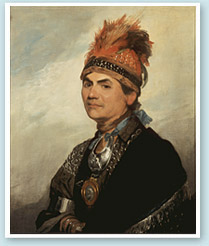
Joseph Brant
was painted by Gilbert Stuart in
1786 when he was in London
Collection
of the Duke of Northumberland.
British
Legion (also known as 5th American Regiment and Tarleton’s
Legion) was formed in 1778 by merging Philadelphia Light
Dragoons, Caledonian Volunteers, and Kinloch’s Light
Dragoons, a small unit raised near Jamaica, Long Island,
under the command of Captain
David Kinloch. In 1780 the unit absorbed the Bucks
County Light Dragoons. Most of the units’ troops
came from Pennsylvania and New Jersey. They fought in battles in the
Southern campaign at Monck’s Corner, Waxhaws, Fishing Creek,
Cowpens, Guilford Courthouse, Warwick Courthouse, and
Charlottesville. Survivors later merged into the King’s
Americans Dragoons. One of the Legion’s commanders was
Lieutenant Colonel Banastre
Tarleton, a brilliant British Army career officer who,
early in the war, captured Continental Army General Charles Lee.
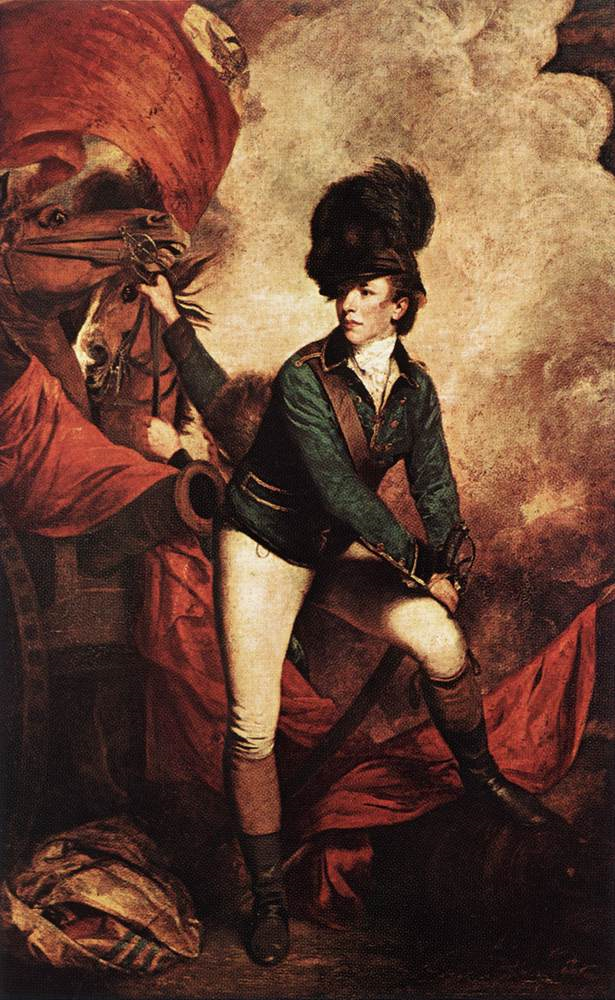
Colonel Banastre
Tarleton, in a portrait by Sir Joshua Reynolds, stands on Rebel
battle flags heaped at this feet. On Flag Day 2006 an
anonymous bidder paid nearly $17.4 million on for four rare flags
from the American Revolution. A flag he captured at Pound Ridge, New
York, is one of the first to display the 13 red and white stripes and
a flag he captured in South Carolina is one of the first to display
13 five-pointed stars on a field of blue.
National
Gallery, London
Bucks County Light
Dragoons, also known as Bucks County Dragoons
Raised in Philadelphia
in February 1778, the unit was sent to New York in 1778 and attached
to the Queen’s Rangers for the 1779 campaign, to the
British Legion for the 1780 campaign, and was permanently
merged into the British Legion in 1782. Lieutenant
Colonel John Watson Tadswell Watson, a British
Army officer from the elite Brigade of Guards, led the dragoons after
the regular commander, Captain Thomas Sandford, was taken prisoner.
Bucks County
Volunteers
Raised in the spring of
1778 under Captain William
Thomas, the unit may have had as few as 15 to 20 men at
times and was often attached to the Queen’s Rangers.
Butler’s
Rangers
Raiders with a
reputation for cruelty, the Rangers were raised by Lieutenant Colonel
John Butler of the British Indian Department in September 1777. In
one of its most notorious raids, about 200 Rangers and 300 Indians
raided Wyoming Valley, Pennsylvania, in June 1778. They continued to
raid the New York frontier throughout the war. During a raid into
Cherry Valley, New York, Butler’s Indian allies killed unarmed
men, women and children. John Butler and his
son Walter kept the New York-Pennsylvania border dwellers living in
fear.
One company was sent to Detroit and raided Rebel
settlements along the western frontier. In the final Ranger action of
the war, one company raided and torched Wheeling in today’s
West Virginia. During their peak years the Rangers mustered more than
500 men. By the end of the war, more than 900 men had served in the
Rangers.
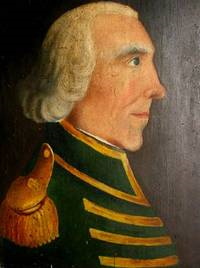
John Butler
Caledonian
Volunteers
Raised in Philadelphia
1777-78, the unit was merged with the British Legion in 1778.
The commander was Lieutenant
Colonel William Sutherland, who was with the British
soldiers at the North
Bridge in Concord when “the shot heard
round the world” began the Revolutionary War.
Canadian Companies
Canadian
referred to French-speaking Canadians, who were reluctant to get
involved in the fight between the British and the Americans. British
officers raising the units announced that two married men would be
pressed into service for every unmarried deserter. The 1st company
was raised from the Trois-Rivières district, the 2nd company
from around Montreal, the 3rd from Quebec. The 1st company served at
the failed siege of Fort Stanwix, New York, during the Burgoyne
invasion. The 2nd and 3rd marched with Burgoyne and were part of the
“Convention Army” that surrendered at Saratoga. Company
officers were Captain Samuel
Mackay, Captain Jean-Baptiste-Melchior Hertel De Rouville, Captain
David Monin, Lieutenant Jean-Baptiste Beaubien, and Captain
René-Amable Boucher de Boucherville.
Carolina Black
Corps, also known as Carolina Corps, Black Carolina Corps,
Black Corps of Dragoons Pioneers and Artifcers
This black unit was
raised as the British Army was leaving Charleston in December 1782.
After the Revolution, the corps of former slaves, amalgamated into a
single unit called the Black Carolina Corps, served in British
Caribbean possessions, which were slave states until slavery
was officially abolished in most of the British
Empire.
Charlestown
Volunteer Battalion
Created when the
British took Charleston, this battalion of volunteers from Charleston
assisted the city’s garrison. It was disbanded around the time
that the British evacuated Charleston in December 1782.
Detroit Volunteers
Raised at Detroit In 1777, the 47-man
company in late 1778 garrisoned Fort Sackville at Vincennes (in what
would become Indiana). The Volunteers’ history ended with the
fall of the fort to Colonel George Rogers Clark’s force in
February 1779, essentially ending British power in the region.
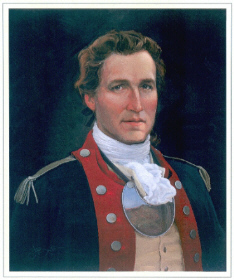
George Rogers Clark
Rogers
Clark Chapter, Ohio Society,
Sons
of the American Revolution
Duke of Cumberland’s
Regiment, also known as Montagu’s Corps.
A regiment former Rebel
prisoners who, after Spain’s entry into the war, agreed to
fight for the British—but only against the Spanish. Most of the
prisoners had been captured after the Continental Army’s
defeats at Charleston and Camden, South Carolina. In February 1781,
Charles Greville Lord Montagu,
last royal governor of
South Carolina, went on board prison ships in Charleston
and recruited hundreds of captives after promising they would not
have to fight fellow Americans. He commanded the regiment, which
initially had 500 men. A second battalion of about 100 men was raised
in New York. In August 1781 the regiment sailed to Jamaica, where it
remained for the rest of the war. After the war, many of Montagu’s
men went with him to Canada, where they were given grants of land.
Dunlop’s
Corps
This mounted infantry
and cavalry unit was based at Ninety Six, South Carolina, in December
1780. Major James Dunlop of the Queen’s Rangers, a
veteran of the battle of Brandywine and Ranger raids in New York and
New Jersey, was given temporary command of what then became known as
Dunlop’s Corps. Twice wounded in South Carolina battles, in
March 1781 Dunlop was wounded again and captured when his 180-man
corps was defeated in a skirmish at Beattie’s Mill. Fellow
Loyalists claimed that he was shot to death while being held
prisoner. His unit was disbanded in July 1781.
Emmerick’s
Chasseurs
Captain Andreas
Emmerick, a German officer serving with British forces, organized the
Chasseurs in August 1777. He selected 100 active “marksmen”
to be drawn from Loyalist units at Kingsbridge, New York, along with
50 men probably used for bayonet support. The corps fought in New
York battles and in 1778 was expanded and organized as two troops of
light dragoons, one light infantry company, one rifle company, and
three chasseur companies. The Chasseurs fought in many skirmishes in
the so-called “Neutral Ground” of New Jersey. Mutinous
officers lost confidence in Emmerick, creating discipline problems
that led to the disbanding of the unit; its men were drafted into
other regiments. In 1809, back in Germany, Emmerick joined an
insurrection against Napoleon’s occupation of Hesse-Kassel. At
the age of 72 he was executed by a firing squad.
Ethiopian Regiment
John Murray, Earl of
Dunmore, last royal governor of Virginia, created this unit of
ex-slaves. In November 1775 Dunmore issued a proclamation promising
freedom to slaves who took up arms for the British. Several hundred
slaves fled their masters and accepted his offer. From them he formed
a regiment and issued uniforms embroidered with the words “Liberty
to Slaves.” After Dunmore’s defeat at Great Bridge,
Virginia, in December 1775, the regiment was involved in the
evacuation of Norfolk and served British forces in the Chesapeake
area. Diminished by smallpox and other diseases, the Regiment sailed
to British-occupied New York and was officially disbanded. But many
survivors remained in British service. They were among the more than
3,000 former slaves who migrated to Canada after the war. The
commander of the regiment, Major
Thomas Taylor Byrd, was
the brother of a Rebel, Francis Byrd.
Florida
Loyalist Military Units
Florida
has been called the “14th
colony” and the only one that did not declare independence from
Britain. In the 1763 treaty ending the
French and Indian War, Britain received the Spanish colony of Florida
and part of the French colony of Louisiana. The British made the new
acquisition into two colonies: East Florida
capital, with St. Augustine its capital and
consisting of most of present-day Florida; and West Florida on
the north shore of the Gulf
of Mexico with its capital Pensacola. West
Florida was bounded by the Mississippi River
and Lake Pontchartrain in the west by the 31st parallel on the north
and the Apalachicola River on the east. Loyalists
fought Spanish rule in both colonies.
East
Florida Militia. 1st Regiment
formed into eight companies but never properly mustered. Attempts
were also made to recruit four companies of former slaves. A 2nd
Regiment was later formed. Records are scanty.
East
Florida Rangers (see also
King's Carolina Rangers). Raised
along the Georgia-Florida border and consisting primarily of East
Florida Tories, the Rangers served in their colony, joined in the
defense of Savannah in 1778, and, with Indian allies, staged
harassment raids along the Georgia frontiers, fighting in the battles
of Kettle Creek and Briar Creek. As the King’s
Rangers, the unit garrisoned Augusta. The
Rangers, using a dismantled church for raw materials, built Fort
Cornwallis to defend Augusta. They merged with Georgia Loyalists in
June 1782. Under their commander, Lieutenant
Colonel Thomas Brown, they fought savagely. (Brown was nicknamed
Burnfoot by Rebels whose fiery torture cost him two toes.) After the
fall of Georgia, Brown and many
Rangers joined thousands of refugees in flight to East Florida, still
in British hands. When that province was returned to Spain in the
1783 peace treaty that ended the Revolutionary War, Brown and his
Ranger refugees settled on Abaco Island in the Bahamas.
East
Florida Volunteers may be
another name for the East Florida Rangers or a name that singled out
volunteers who were drafted into the Rangers.
Natchez
Volunteers
Retired
British officers, seeking to aid Major General John Campbell,
commander of British forces in West Florida colony, raised this unit,
which included a motley crew of Tories who called themselves the West
Florida Independent Rangers. Learning of
Spanish plans to attack Campbell at Pensacola, the capital of West
Florida, they gathered volunteers, including Indians, to create a
diversion at Natchez (in present-day Mississippi), site of a former
British outpost, Fort Panmure. On April 22, 1781, the Spanish
garrison fled the fort, believing that the Natchez Volunteers, under
Captain John Blommart, had undermined it with explosives. In June
1781, after the Spanish defeated the British at Pensacola, they
retook the fort, and captured Loyalists who were there, ending the
service of the Natchez Volunteers. (See also West
Florida Independent Rangers)
West
Florida Independent Rangers, led by Captain
Thaddeus Lyman of Bayou Pierre, Louisiana, became involved with the
Natchez Volunteers (see).
The short-lived ranger unit joined in
an attempt to take Fort Panmure, a former British outpost, seized by
Spanish troops during their invasion of the British colony of West
Florida. In the aftermath of the failed operation, a party of about
100 refugees fled, traveling, on foot and on horse, from Natchez to
Savannah Georgia in 149 days.
West
Florida Loyal Refugees (displaced Tories
called themselves Refugees) were raised at
Pensacola in 1777 as a cavalry corps of two companies. The unit was
initially used to suppress Rebels’ illicit rum trade in the
Mobile Bay area. The unit surrendered to Spanish invaders in June
1780.
West
Florida Provincials (another name for
Loyalists) went into service with about 67
enlisted men and 17 officers. Between March and November 1778
Lieutenant
Colonel John McGillivray led
an expedition against Rebels,
journeying from Mobile to Natchez to Manchac and back return.
West
Florida Royal Foresters, raised
in mid-1780, fought the Spanish force that invaded the colony and
took what are today’s Mobile and Daphne,
Alabama. In January 1781 they joined British troops in a failed
attempt to retake the towns. They also helped defend
Pensacola in July 1781and were taken to Havana as Spanish prisoners.
By the time they were repatriated to New York, there were only two
officers, one sergeant, and ten enlisted men. The unit was disbanded
in August 1782.
Forshner’s
Independent Company
A small unit operating
in the “Neutral Ground” of New Jersey. Little is known
about its missions. One of few reports tells how Andrew Forshner and
two recruits crossed from Staten Island to New Jersey. After repeated
narrow escapes from American patrols, one recruit was captured.
Forshner and the other recruit managed to contact local Loyalists and
gather detailed intelligence before stealing a canoe and paddling it
back to Staten Island.
Garrison Battalion
(also known as Royal Garrison Battalion or Royal
Garrison Battalion of Veterans)
The unit was formed in
New York City in October 1778 under the command of Lieutenant Colonel
William
Sutherland of
the British Army and sent to Bermuda to defend against a French or
American attack that never happened. The British feared that
pro-American Bermudians would aid invaders. (Sutherland earlier had
been commander of the Caledonian Volunteers.) Reinforcements
arrived with Lieutenant Colonel Robert Donkin in 1779. Most of the
men in the battalion were British Army veterans and recovering
invalids.
Georgia
Loyalist Military Units
Georgia,
the only colony to be fall to the British during the Revolution,
fostered several Loyalist military units with many British and
American commanders.
Georgia
Artillery was raised in
Savannah by Alexander McGoun. He had been named by the Rebels’
Council of Safety in Georgia as a person “whose going at large
is dangerous to the liberties of America.” The Rebels later
confiscated his property, along with the property of 224 others named
by the Council.
Georgia
Light Dragoons consisted of Scot soldiers of
the British Army’s 71st Highlanders and Loyalists. Another
unit, known as the militia element of the Georgia Light Dragoons,
fought in several battles in Georgia. Reports of a unit known as East
Florida Volunteers may refer to the Georgia
Dragoons. Actions involving the two units overlapped and both appear
to have been present at some of the same events.
Georgia
Loyalists was raised
in Georgia in 1779 and sent to Charleston in December 1779. The unit,
which mustered only 72 men, merged with the East
Florida Rangers in June 1782 and was sent to
New York, where it was disbanded.
Georgia
Militia, under the command of Lieutenant
Colonel James Grierson of Augusta, gained a reputation as ruthless
foes. Grierson was singled out particularly for following British
orders to execute Rebels who broke their oath of loyalty to the king.
Rebels took Grierson prisoner in Augusta on June 5, 1781. He died two
days later, reportedly murdered in vengeance for his deeds.
Volunteers
of Augusta was a cavalry unit
formed of Loyalists who called themselves
Augusta Refugees. A song composed for the Volunteers included the
words The Rebels they
murder, Revenge is the word/Let each lad return with blood on his
sword.
Under the
command of Captain
James Ingram, they fought in a small,
inconclusive battle along Ogeechee River in May 1782.
1781-1782
Governor Wentworth’s
Volunteers
John Wentworth,
governor of the New Hampshire Grants (later Vermont) raised this unit
in 1776 to defend himself and his realm. He gathered about 20 men,
all certified as respectable and well-educated Loyalists, around him
and then he and the Volunteers fled to British-held Long Island,
where its first muster was taken. By the summer of 1778, the
Volunteers numbered 26. They are next heard from in March 1779 when
they joined other Loyalist forces in British-occupied Newport, Rhode
Island. They were later incorporated into the King’s
American Dragoons.
Guides &
Pioneers
Raised in New York in
1776 and attached to the Loyal American Regiment, the unit
served in 1781 in the siege of Charleston and in a raid into
Virginia. Beverley Robinson of New York, a wealthy Loyalist, raised
this unit and the Loyal American Regiment. He also played a role in
the treason of Benedict Arnold. Other commanders included Captain
Andreas Emmerick (see Emmerick’s Chasseurs);
Major Samuel Holland, former
royal surveyor-general of northern colonies; and Major John
Aldington, who enabled British invaders to make a surprise invasion
of New Jersey in November 1776 by leading them up a steep, narrow
path of the Palisades,

Guides &
Pioneers (Southern)
About a company or more
of these men, under Major Daniel
Manson, were regularly with Cornwallis’
army in the South. Small units probably assisted in the construction
or strengthening of fortifications and in the building and repairing
of bridges and boats.
Harkimer’s
Batteaux Company
Batteaux were mid-sized
boats used for various tasks. Captain Jost Harkimer’s batteaux
were used as transport during Colonel Barry
St. Leger's unsuccessful
Mohawk Valley campaign, which was part of Burgoyne’s 1777
invasion of New York from Canada.
Howetson’s
Corps
Lieutenant
Colonel James Hewetson, a retired British Army officer, formed the
unit, which initially had 171 men. The corps fought in a
skirmish near Livingston Manor in May 1777. Afterward, Rebels hanged
Hewetson (also spelled Howetson and Huston) for
recruiting Loyalists.
Jamaica Independent
Companies
Formed at Bluefields in
what is now Belize from survivors of various Jamaica and Mosquito
Coast units, it may have been merged into Odell’s Loyal
American Rangers.
Jamaica Corps (also
known as Amherst’s Corps)
Despite its name, the
unit was raised in 1780 in New York and in Charleston. In April 1783
it was amalgamated into the Duke of Cumberland’s Regiment
and Odell’s Loyal American Rangers. The unit’s
secondary name honored Jeffrey Amherst, a hero of the French and
Indian War. Amherst declined command of British forces in North
America and took no part in the Revolutionary War.
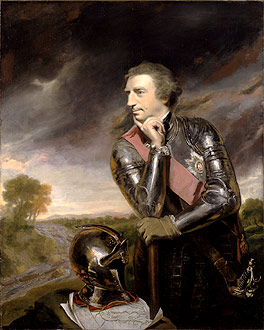
Jeffrey Amherst
Joshua
Reynolds, 1765
Jamaica
Loyalist Military Units
In
1655, the British captured Jamaica and used the plantation
slavery of Jamaica to launch the triangular trade: England’s
manufactured goods, Africa’s slaves, and the Caribbean’s
sugar. When Spain entered the Revolutionary War as an American ally,
Britain needed to protect Jamaica. And Loyalist troops, expecting to
serve in America, found themselves in a hot, fever-stalked outpost of
the British Empire.
Jamaica
Legion was raised in
Jamaica in late 1779. “Mostly composed of sailors,” the
Legion numbered about 210 men. It was sent to Nicaragua in February
1780. Ravaged by fever, the Legion in October 1780 was incorporated
into the Jamaica Volunteers.
Jamaica
Light Dragoons was raised
in July 1780 in Jamaica and was also known as Lewis’
Corps of Light Dragoons or Light
Horse. The unit had about 98 men, nearly half
of whom were sent to various places in Central America.
Jamaica
Rangers emerged in June
1782 from a royal proclamation calling for
the raising of “two
Battalion of free mulattoes and Blacks” as “a means of
removing the Regular Troops to more healthy Stations, by which a
number of very valuable lives may be preserved.” This was the
first ranger unit made up of mulattos and free blacks.
Jamaica
Volunteers, also known as
Royal Jamaica Volunteers, was
raised in Jamaica in October 1779. The unit,
of about 240 men, took part in a campaign aimed at weakening Spanish
power in South America. In 1780 a British amphibious force—whose
ships were commanded by Captain Horatio Nelson, the future hero of
Trafalgar —landed on the coast of today’s Nicaragua and
ascended the San Juan River. During one of the battles of this
disastrous campaign, a Spanish musketball burrowed into Nelson’s
right arm, which had to be amputated. More than a quarter of the
British landing force was killed, wounded, or infected by yellow
fever.
Royal
Batteaux Volunteers, likely the same unit as
the Royal Batteaux Corps, was
raised
in Jamaica sometime in 1779. In February 1780 the unit was sent to
present-day Belize and Nicaragua. Devastated by tropical diseases, in
October 1780 the unit was incorporated into the Jamaica
Volunteers.
James Island Troop
of Light Dragoons, also known as James Island Troop of Horse
This small unit, under
the command of British Army Captain
Alexander Stewart, fought a skirmish against Major
General Nathanael Greene’s Continental Army on August 21, 1781
at Howell’s Ferry, (also known as Russell’s Ferry), South
Carolina. The troops was named after an island that was a
steppingstone to the British capture of Charlestown in 1780.
King’s
American Dragoons
This unit was one of
many Loyalist cavalry units formed to augment the relatively few
British dragoons who served in the war. Raised in 1781, the unit
served briefly in South Carolina and reported killing 40 Rebels in a
battle at Wambaw Creek in February 1782. The commander was Lieutenant
Colonel Benjamin Thompson, whose military career began in
a New Hampshire militia. Prior to raising the unit, Thompson was a
British spy in Boston, using invisible ink to send his messages.
After the war he moved to England, where he became Lord Rumsford, a
noted scientist who established that heat is molecular motion, and
not a fluid.
King’s
American Rangers
On May 1, 1779,
Lieutenant Colonel Robert Rogers, storied commander of Rogers’
Rangers in the French and Indian War, was commissioned by General Sir
Henry Clinton to raise two battalions of Rangers. The 1st battalion
had 133 men. The 2nd battalion, numbering 193 men, was raised by
Rogers’ brother James. Initially recruited in Nova Scotia, the
battalion was garrisoned for a time at Fort St. John’s on the
Richelieu River (now Saint Jean, Quebec).
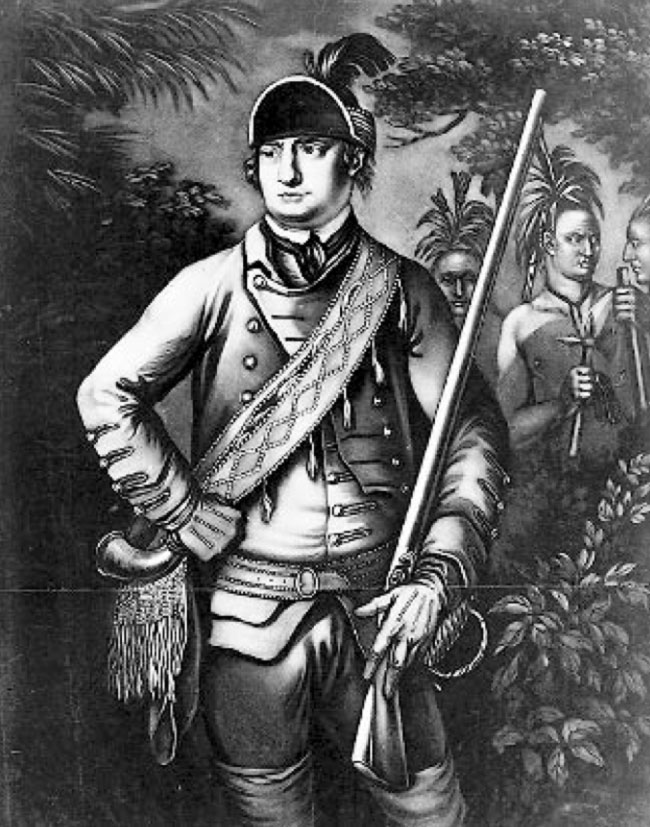
Robert Rogers mezzotint by Thomas
Hart, 1776
Fort
Ticonderoga Museum
King’s
American Regiment (also known as the 4th American
Regiment)
Raised on Long Island,
New York, this regiment of about 500 men served in New York, Rhode
Island, South Carolina, and Georgia. Members came from the Hudson
River Valley, New York City, Connecticut, and Rhode Island. The
commander, Edmund Fanning, was an aide to William Tryon, royal
governor successively of North Carolina and New York. When Tryon
raided New Haven, Fanning, a graduate of Yale, intervened to save his
alma mater from being destroyed. In gratitude, Yale in 1803 awarded
him an honorary doctorate. After the war, the regiment was placed on
the regular British Establishment, an honor bestowed on only a few
Loyalist units.
|
|
|
|
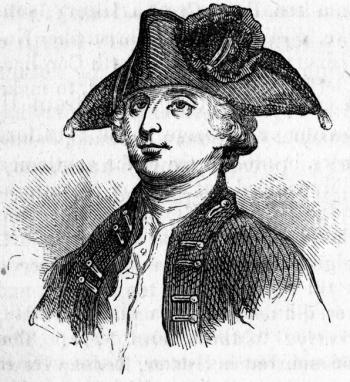
Edmund Fanning
North Carolina
Collection, University of North Carolina at Chapel Hill Libraries.
|
|
|
King’s
Carolina Rangers (also known as King’s Florida Rangers
and King’s Rangers)
Originally raised in
June 1776 as East Florida Rangers, the unit fought in many
skirmishes defending East Florida. After taking part in the invasion
of Georgia in 1779, the unit was reorganized and named the King’s
Carolina Rangers. Georgia Loyalists later merged with the Rangers.
Evacuated from Savannah in 1782, the unit was transported to
Charlestown. Along with other Loyalist units, the Rangers were sent
to St. Augustine to garrison East Florida. At the end of the war the
unit was sent to Nova Scotia and disbanded.
King’s Loyal
Americans
In 1776, Ebenezer
Jessup, a wealthy Albany Tory, enlisted and outfitted 90 men of this
unit. Hounded by Rebels, he soon took his family to Canada and never
returned to Albany, losing his extensive properties to confiscation.
Also in the corps was his brother Edward. Jessup’s Corps fought
and suffered heavy casualties during Burgoyne’s invasion of New
York in 1777. Survivors went into McAlpin’s Corps and
the Queen’s Loyal Rangers (Peters’ Corps) at St.
John’s, Quebec in 1781. When the unit was disbanded in 1784,
its members settled in Grenville County, Ontario.
King’s
Orange Rangers
The unit was formed in
1776, mainly of men from New Jersey and Orange, New York. Many of
them were tenants on the estates of John Bayard, the prominent
landowner who raised and commanded the unit. Bayard was a Son of
Liberty who turned Tory. Each volunteer was to
“receive 40 shillings advance with new cloaths, arms, and
accoutrements and everything necessary to compleat a gentleman
volunteer.” The Rangers saw action in coastal New Jersey
and New York. When Bayard killed a junior officer in an argument, all
members of his sergeants’ guard deserted and his unit began to
dissolve. Reduced to about 200 men and on verge of mutiny, the unit
was transferred to Halifax, Nova Scotia, in October 1778. Two months
later, one company was transferred to Liverpool, Nova Scotia, to
fight off Rebel privateers and man Liverpool’s Fort Point.
After the war, when the unit was disbanded, many settled in Canada on
land granted for service.
King’s Royal
Regiment of New York, also known as Johnson’s Greens,
Royal Greens, Sir John’s Corps, and King’s Royal
Yorkers.
The regiment was raised
by Sir John Johnson, son of the foremost British Indian agent in
North America. His recruiting began in June 1776 after his escape
from a Rebel force sent to seize him in the Mohawk Valley. Most
recruits were Loyalist refugees from the Mohawk and Schoharie
valleys. The regiment served in Burgoyne’s
1777 campaign in New York, fighting with a force of Loyalists,
Indians, and British soldiers ordered to subdue Rebels in the Mohawk
Valley. At Oriskany, they fought in one of the bloodiest battles of
the Revolution. Driven back to Canada, they later emerged as fierce
raiders who terrified and torched settlements along the New York
frontier, helping the British control land north of the valley. In
1783, the 1st Battalion was disbanded and its veterans settled in
Canada along the St. Lawrence Valley; the following year, the 2nd
Battalion was disbanded and settled in what became Canada’s
Frontenac, Lennox,
and Addington counties.
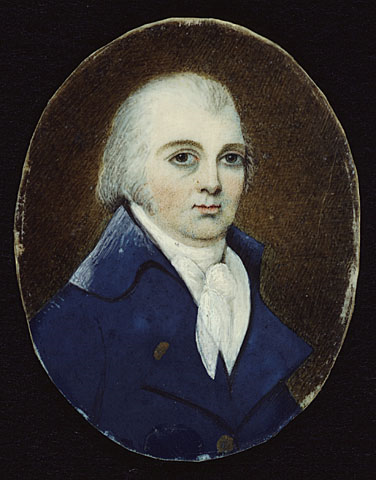
Lieutenant Colonel Sir John Johnson
Library
and Archives Canada
Loyal American
Association, also known as Loyal Associated Volunteers
Timothy
Ruggles, a veteran of the French and Indian War, became a Loyalist
brigadier general and raised the Association in 1775 in
Marshfield, the only Massachusetts town to oppose the Patriots’
Continental Association. Membership reached about 300. The Loyal
American Association, expected to be the beginning of a
Massachusetts-wide Tory force, was provided British arms and given
protection at first by 100 British troops. On April 20, 1775, a day
after the battles of Concord and Lexington, when a large number of
Patriot militia men threatened Marshfield, the British troops
evacuated the town, along with as many as 200 Loyalists. The 5th
Company of Associators Milita (essentially the same unit as the
Associated Loyalists of Marshfield) assembled in British-occupied
Boston on July 5, 1775 and began patrolling the streets to prevent
all “disorders… by either Signals, Fires, Thieves,
Robers, house breakers or Rioters.”
Loyal American
Rangers
Raised in New York in
1780 from Continental Army prisoners and deserters, along with Tory
refugees, the unit had about 300 men in six companies. They served in
Kingston, Jamaica, and were en route to Pensacola in May 1781 when
word was received of that city’s fall.
Loyal American
Regiment
Raised in mid-March of
1777 by wealthy Beverley Robinson, the unit consisted almost entirely
of New York loyalists from lower Dutchess and Westchester Counties.
Robinson, a friend of George Washington when both lived in Virginia,
managed 60,000 acres and 146 tenant farms in Dutchess County. His
tenants and their relatives were liberally sprinkled through the
regiment, which he commanded. The regiment fought in battles in New
York and New Jersey through to December 1780, when it embarked for
Virginia under the command of a new British brigadier general,
Benedict Arnold. They later returned to their New York-New Jersey
battlegrounds and joined in a raid on Pleasant Valley, New Jersey,
under Brigadier General Cortland Skinner of the New Jersey
Volunteers. In September 1781, again commanded by Benedict
Arnold, they joined in his terror attack on New London. After
garrison duty in Long Island, they embarked for Nova Scotia in
September 1783.
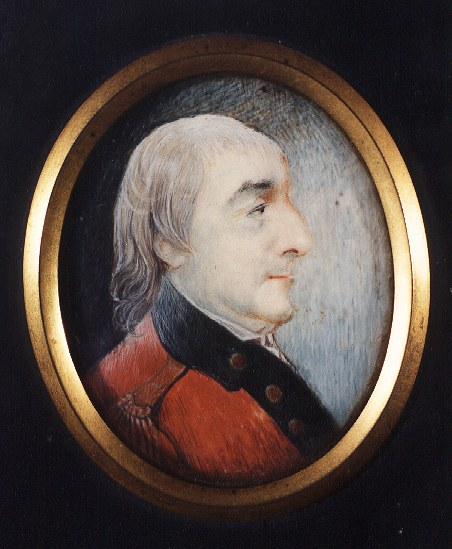
Beverley Robinson
New
Brunswick (Canada) Museum
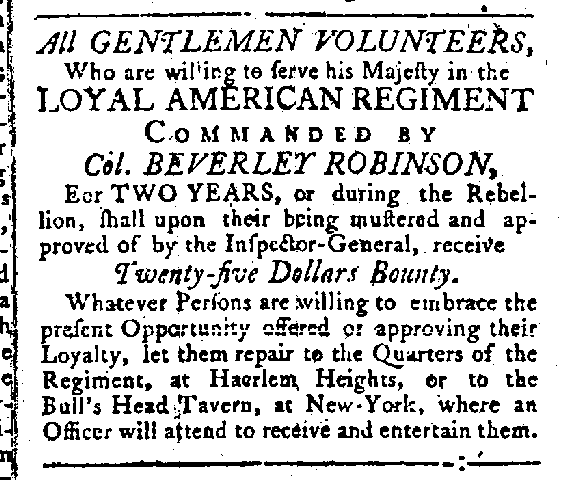
Recruiting
Poster for the Loyal American Regiment
Loyal Associated
Refugees
Organized by George
Leonard, a Massachusetts Loyalist, the unit was a sea-going raiding
force of Loyalist sailors and soldiers. In March 1779, joined by a
company of the King’s American Regiment, the unit
raided, but failed to occupy, Bedford (now New Bedford),
Massachusetts. In June 1779 the Refugees became part of the force
that General William Tryon led during his terror raids on Connecticut
coastal towns.
Loyal Foresters
(Forresters)
This unit, which
included Loyalist Indians, was raised to serve with Guy Johnson of
the British Indian Department. The commanding officer was Lieutenant
Colonel John Connolly, a native of Lancaster County,
Pennsylvania. He was captured by Rebels in November 1775 before he
had a chance to carry out his plan to lead a campaign against Rebels
in and around the Falls of the Ohio, where Louisville now stands.
Loyal Irish
Volunteers
James Forrest, an Irish
emigrant from Boston, enlisted Loyalists there in the fall of 1775
and took command. His men wore white cockades in their hats. The unit
was disbanded after the British Army and hundreds of Tories evacuated
the city in March 1776.
Loyal New Englanders
Raised at Newport,
Rhode Island in 1777, under the command of Lieutenant
Colonel George Wightman, the unit served there until the
British Army evacuated the port in October 1779. Next, the New
Englanders became part of the garrison at the Tory stronghold of
Lloyd’s Neck, Long Island. By 1781 there were only about 30 men
in the unit, and they were absorbed into the King’s American
Dragoons and Volunteers of New England.
Loyal Newport
Associators
In 1764 Newport’s
Artillery Company’s guns fired on the Royal Navy warship, HMS
St. John, in New England’s first armed resistance to the
king. A decade later, in December 1776, when the British began their
occupation of Newport, about half of the
company, under Captain (later Brigadier General) John Malbone, joined
the Rebels and the rest joined the Associators and other Tory
units. In 1792, the Rhode Island State Legislature reaffirmed the
unit’s charter, making it the nation’s oldest active
military unit still operating under its original charter.
Loyal Rangers
Formed in 1781, the
unit was created from several smaller companies, including the
Queen’s Loyal Rangers and the King’s Loyal
Americans. Edward Jessup, born in Stamford,
Connecticut, was living in New York in 1759
when he served in the French and Indian War. In 1776, with his
brother Ebenezer and other Loyalists from the area, he joined Sir
John
Johnson’s regiment. Captured while
serving with the King’s Loyal Americans, he was later
released and in 1781 was named commander of the new Loyal Rangers,
which was assigned to raiding parties in New York state and to
garrison duty in southern Quebec.
Loyal Refugee
Volunteers
Abraham Cuyler, a
wealthy landowner and Tory mayor of Albany, New York, raised and
commanded this unit of about 150 men, including runaway slaves
gaining freedom under the British. The Volunteers built a blockhouse
fort at Bull’s Ferry, New Jersey, across the Hudson River from
British-occupied New York City. From that redoubt they raided Rebel
farms in Bergen County, New Jersey, getting supplies and cutting down
trees for wood, which they sold to the British across the river. In
July 1780 the blockhouse successfully warded off a Rebel attack of
about 1,000 men under Continental Army General Anthony Wayne. The
unit later moved to Bergen Point (Bayonne), New Jersey, and to the
site of Fort Lee, where Rebels tried to dislodge them as they began
building a new blockhouse fort there. Finally, the Tories withdrew to
Bergen’s Neck and in the fall of 1782 disbanded. after many
left for Nova Scotia. Other commanders were Major
Thomas Ward and Major Philip Van Alstine.
Loyal Rhode
Islanders
Raised in Newport in
March 1777 under Colonel Edward
Cole, a veteran of the French and Indian War, the unit
was disbanded in November 1777 because of a lack of recruits.
Maryland
Loyalists
The core members of
this 300-man unit were Maryland Tories who fled to British-occupied
Philadelphia. There, in October 1777, the 1st Battalion of Maryland
Loyalists was raised by James Chalmers, a wealthy Eastern Shore
planter. When the British Army evacuated the city in June 1778, the
Marylanders also left and fought in the battle of Monmouth. First
sent to Halifax, they later served in Jamaica and Pensacola, capital
of the British West Florida colony. Captured when Pensacola fell to
the Spanish, they were paroled to New York City. By the end of the
war, small pox and desertions had shrunk the battalion to about 100
men. They, along with their wives and children, sailed to Canada,
where they had been granted land. Their ship, HMS Martha, ran
aground in the Bay of Fundy and sank. Most men drowned, but many
wives and children survived.
Maryland Royal
Retaliators
Nearly 1,300 Loyalists
swore oaths to join this corps, raised by Marylanders Hugh Kelly and
James Fleming, mainly in Pennsylvania. The Retaliators had ambitious
plans to recruit as many as 4,000 men for a campaign to aid the
British in the taking of a large swath of Pennsylvania and Maryland.
But Rebels learned of the plan, arrested Kelly and some 170 men;
three were convicted of treason against Maryland and hanged. Fleming
and others escaped to join British forces in North Carolina. After
the British surrender at Yorktown, both men made their way to
British-occupied New York. Kelly was later reported living in Nova
Scotia.
McAdam’s
Independent Company of Volunteers
Far more is known about
John Loudon McAdam than about the Loyalists he recruited in New York
for his Company of Volunteers. Born in Scotland, he sailed to New
York as a youth and lived with his uncle in New York City. During the
Revolutionary War, he was the commissioner for prizes ships captured
by the Royal Navy and British privateers. He offered more than 450
ships for auction, collecting fees for those he sold. Those fees
provided some of the basis for his fortune when he moved back to
Scotland, bought land, got involved in local road-building, invented
a new paving process—and gave the world “macadamized”
roads. As for his Volunteers, little is known; they were among the
countless Loyalists who were recruited in Tory Town, as New York City
was called.
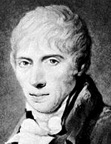
John Loudon McAdam
McAlpin’s
Corps of Royalists
When General John
Burgoyne invaded New York from Canada, among his forces were Loyalist
volunteers, including McAlpin’s Corps, commanded by Major
Daniel McAlpin. After serving 40 years in the British Army, McAlpin
had retired in New York. In 1774 he bought about 1,000 acres on the
west side of Saratoga Lake and became a prosperous farmer. After
Rebels seized his property, he became a soldier again. He received a
warrant from General Sir
William Howe, secretly raised a unit of about 180 men and
officers, and marched off with Burgoyne. After the battle of
Freeman’s Farm, some of his men were drafted into British
regiments that had suffered heavy casualties. Loyalist survivors of
the Burgoyne expedition were placed in the King’s Royal
Regiment. In May1779, McAlpin’s own surviving men were
returned to him. They were mostly assigned to garrison duty and
fortification construction in Quebec Province. Although seriously
ill, McAlpin continued in command until he died in July 1780.
Negroe Volunteers
This unit was raised in
Savannah during the 1779 siege of that British-held city by a joint
American-French force. The black Loyalists, unlike ex-slaves given
menial Army chores elsewhere, the Negroe Volunteers were used as
soldiers armed to fight the besiegers. One of the two armed companies
was commanded by Captain Hartwel Pantecost (who would later become an
officer in the James Island Light Dragoons); the other by
Captain John McKenzie of the British Legion. The unit was
probably disbanded by the end of the year. The British remained in
control of Savannah until July 1782.
Newfoundland
Regiment, also known as His Majesty’s Newfoundland
Regiment of Foot
In September 1780
British authorities authorized the raising of a force of 300 men to
defend the colony. Many were recruited from the recently disbanded
Newfoundland Volunteers; others may have been drafted from the
Artificiers and Labourers, since that unit and the
Newfoundland Regiment were both commanded by Robert
Pringle, a major by 1780. The regiment was garrisoned in
and around St. John’s until the end of the war.
Newfoundland
Volunteers, also known as Royal Newfoundland Volunteers
In 1778 Captain Robert
Pringle, an officer in
the Royal Corps of Engineers, was authorized to form the Volunteers,
the first recorded military force to bear the name “Newfoundland.”
Its members were mainly civilian construction workers employed by the
British Army. They built a military road and worked on Fort Townsend
at St. John’s. The unit was disbanded the following year in a
dispute over the paying bounties.
New Hampshire
Volunteers (also known as Stark’s Corps)
In spite of its name,
this unit was raised in New York City and Philadelphia by William
Stark of New Hampshire, who had commanded a company of Rogers’
Rangers during the French
and War. William Stark was the older
brother of Rebel General John Stark, the hero of the Battle
of Bennington. Stark, originally a Rebel
became dissatisfied with the way he was treated. So he went to
British-occupied New York and offered his military services. His unit
was raised in the spring of 1777 but seems to have been soon
disbanded, with its men being absorbed into the Queen’s
American Rangers in New Jersey. Later, would-be recruits wound up
in the 2nd battalion of the New Jersey Volunteers and the
King’s Orange Rangers. Several officers joined the
Guides & Pioneers.
New
Jersey Loyalist Military Units
Cortland Skinner, the last attorney
general under the Royal government of New Jersey, was commissioned a
brigadier general by British authorities in September 1776 and
empowered to raise a brigade of six battalions to be known as the New
Jersey Volunteers. (Royal Governor William
Franklin also made Skinner a major general
of militia.) Skinner did raise his battalions by December 1776, and
he provided them with green uniforms, a color that came to be
associated with armed Tories. But, because none of the battalions
reached their authorized strength, the brigade was eventually reduced
from six battalions to four. The Continental Army, during victorious
battles at Trenton and Princeton, captured several of Skinner’s
commissioned officers, including one who had documents showing that
he was attempting to raise an Irish battalion for Skinner.
New
Jersey Militia. Sketchy accounts indicate
that 50 to 60 militia men from Monmouth County crossed to
British-held Staten Island in June 1776, bringing their personal
arms, “a stand of colours,” and not much else. With his
headquarters at New Brunswick during the British occupation there,
Skinner reorganized the Monmouth
County Militia, under
his commission as major general of militia, striving to make the
militia able to prevent “small parties [of Rebels] from
entering the County, and distressing the People.”
New
Jersey Volunteers, also known as Skinner’s
Greens. When
Skinner was given his commission, the 1st
battalion of this corps was already forming, with many more Loyalists
only awaiting the arrival of British troops in New Jersey before
joining them as Tory allies.
1st
battalion of New
Jersey Volunteers, established
on July 1, 1776, served as garrison troops at Richmond, Staten
Island, while training. They entered New Jersey in December 1776 as
part of a force pursuing Washington during his retreat from Fort Lee.
Several hundred more recruits were raised in Monmouth County. In
January 1777 the battalion formed part of the British garrison at New
Brunswick and in June 1777 returned to Staten Island, its station for
the next five years.
2nd
battalion of New
Jersey Volunteers was
established in
November 1776 by Lieutenant Colonel John
Morris, a retired lieutenant of the British Army’s 47th
Regiment of Foot. On January 2, 1777 four soldiers of the unit were
killed in battle and as many as 30 others captured during the battle
at Monmouth Court House. The battalion also fought in smaller
actions. In April 1777, ordered to New York, the unit was assigned to
service with the Royal Artillery Regiment, recruiting Rebel deserters
to fill it ranks. The unit guarded woodcutters and ships. When it was
broken up, men were drafted into the 1st and 4th battalions.
3rd
Battalion of New
Jersey Volunteers was established in November
1776. Its first commander, Edward
Vaughan Dongen, was mortally wounded in a battle with a large Rebel
force retaliating against Tory raids. Members
of the battalion were notorious raiders throughout 1777. In December
1778 they sailed to Georgia, where they joined British troops who
took Savannah. Through 1779 and into 1780, the unit served in
Georgia. When the unit’s light company was ambushed at
Musgrove’s Mills, every officer was wounded and many men were
killed or wounded. Other companies staged raids out of their garrison
at the town of Ninety Six. Some men of the Volunteers
of Ireland, a disbanded regiment, were
brought into battalion. In January 1783 the unit returned to Long
Island, losing many as deserters. At the end of the war, the
remaining men and their families sailed to Nova Scotia, where the
unit received a grant of land.
4th Battalion of New Jersey Volunteers
was established in the fall of 1776
by Bergen County surgeon Abraham Van Buskirk. The unit consisted of
ten companies of varying strength. Members conducted raids against
Rebel homes and fighters in Bergen County and garrisoned parts of
Bergen Neck and Staten Island. In the summer of 1779 the battalion
moved into nearby Paulus Hook, now Jersey City. A contingent serving
with the American Volunteers
landed in Georgia in February 1780 and advanced northward to link up
with other British troops near Charlestown. Back north, a
reorganization brought companies of the 4th Battalions (also the 1st
and 2nd) and several other units into the Provincial
Light Infantry, which joined an expedition
that sailed for Virginia in October of 1780. On February 27, 1781 a
party of 20 men from the 4th held off ten times their number until
arrival of the rest of the unit. On September 8, 1781 the battalion
was part of the British force that defeated General Nathanael Greene
at Eutaw Springs, South Carolina. In September 1783 the unit embarked
for Nova Scotia.
5th
Battalion of New Jersey Volunteers of about
250 officers and men from
Sussex County was raised
by Joseph Barton in November 1776. Early in 1777, the unit went on
raids for a while before taking on garrison duty on Staten Island.
The battalion saw little more battle action before it was disbanded,
its men being transferred to a reorganized 1st battalion.
6th
Battalion of New Jersey Volunteers was raised
in December 1776 by Isaac Allen, a Trenton
lawyer. The men came from the Hunterdon County area, including
Trenton and Princeton. Washington’s attack on these places
slowed down recruiting and cost the battalion two officers. After a
battle in February 1777, in which several men were killed and about
60 taken prisoner, the battalion set up quarters on Staten Island.
Undersized to start with and with ranks depleted, the battalion was
merged into the 3rd Battalion.
West
Jersey Volunteers were
raised in Philadelphia in January 1778 and served primarily in and
around Billingsport, New Jersey, until the evacuation of Philadelphia
in June 1778. Because it was an under-strength regiment, its men were
drafted mainly into the 1st and 3rd battalions of the New
Jersey Volunteers and the British
Legion.
New
York Loyalist Military Units
After
the British conquest of New York City and Long Island in 1776,
Loyalists chose the occupied territory as their new home. Prominent
Loyalists, such as leaders of the DeLancey and Robinson families,
quickly raised regiments. Many Tories, who called themselvesRefugees,
began arriving from the neighboring area, from Pennsylvania, and even
from the South. Many royal militias became Loyalist military units.
The American Volunteers, while
serving as a detached corps from the British Army, trained New
York militias.
DeLancey’s
Brigade also
known as the New
York Loyalists,
was probably the largest armed Tory organization in New York. The
brigade—three battalions of 500 men each—was raised by
Oliver DeLancey, a wealthy New York merchant who resided in the
Morrisania section of the Bronx (then part of Westchester County).
Some of the men in the 3rd battalion were said to be Rebels captured
during the battle of Long Island and given a choice: Join the
Loyalists or rot in a prison hulk in New York harbor. At first,
members of DeLancey’s Brigade served as a police force in New
York City. Later, they garrisoned forts at
Kings Bridge and on the north shore of Long Island, where they often
were accused of ill-treating Loyalist civilians. The 1st and 2nd
battalions served in East Florida, then in Savannah. So many men were
killed in battles there and in South Carolina—at Eutaw Springs
and during the siege of Fort Ninety-Six—that the two battalions
were merged in February 1782. Battalion
commanders included Lieutenant Colonel John Harris Cruger, Colonel
George Brewerton, Lieutenant Colonel Stephen DeLancey, Major Thomas
Bowden, and Colonel Gabriel G. Ludlow. He became the first mayor of
Saint John, the destination of many of the Loyalists who sailed to
Canada after the war.
Loyal
Volunteers of the City of New York was under
the command of David Mathews, royal mayor of New
York City. Locke’s Independent
Companies, raised in New
York by Joshua
Locke in
1779
was
probably included among the Volunteers, as was the Mayor’s
Independent Company of Volunteers.
Mathews and his followers were
involved in a conspiracy known as the Hickey Plot, a complex
conspiracy aimed at infiltrating and subverting the defenses of New
York and kidnapping or assassinating George Washington. Mathews,
placed in house arrest in Litchfield, Connecticut, escaped and
returned to New York, where he resumed his office under the British
occupation. Shortly before British troops evacuated the city in
November 1783, Mathews sailed to Nova Scotia.
Nassau
Blues, raised in May
1779, was disbanded in December of the same year, when most members
then joined the New York Volunteers.
William Axtell was supposed to raise 500 men from the Nassau, New
York area, but he was said to have only raised about 30 men.
Jamaica-born William Axtell was heir to a large New Jersey estate
when he arrived in America in 1746. He married Margaret De Peyster,
daughter of Abraham de Peyster, Jr., and through her mother, a Van
Cortlandt—two of the wealthiest Loyalist families of the era. A
member of the Governor's Council in 1776, Axtell was commissioned a
colonel and given command of the Blues, known to foes as the “Nasty
Blues” because of reports of torture chambers in at Axtell’s
palatial Brooklyn mansion, Melrose Hall. Rebels confiscated Melrose
Hall, which was purchased after the war by a Continental Army officer
who had married Axtell’s adopted daughter.
New
York Volunteers were sent
to East Florida in October 1778 and helped to defend Savannah in
September 1779. After battles in Charleston, Camden, and Hobkirk’s
Hill, South Carolina, they returned to New York in August 1782. The
unit was disbanded in Canada in 1783. Units in
the Volunteers were also known as the New York
Companies, the 3rd
American Regiment, and the
1st Dutchess County Company,
which became the 3rd Regiment.
King’s
County Militia was commanded by Colonel
William Axtell, who had had little success
raising the Nassau Blues. He
did better with this militia, whose muster in
November 1777 showed seven companies of infantry, 25 sergeants, 26
officers, 7 drummers, 337 rank and file (the usual military term for
ordinary soldiers), and a troop of light horse with 5 officers, 3
sergeants, and 32 rank and file. The unit had a religious tinge:
Officers signed a “Declaration Against Popery,” denying
the doctrine of transubstantiation and objecting to idolatry.
New
York Rangers (also known as the
First
Independent Company of Rangers, was
commanded by Christopher
Benson whose recruits were from New York City and Long Island. The
Rangers, part of the New York City
garrison, dealt with parolees and prisons and performed other
military police duties. In August 1777 the Rangers arrested Colonel
Ethan Allen at a tavern in New Lots, Long Island, for violating his
parole.
Queen's
County Militia troops assisted Associated
Loyalists in repelling and attempted landing
at the Tory stronghold of Lloyd’s Neck, Long Island, by a force
about 450 troops, most of them French.
Richmond
County Militia was commanded by Colonel
Christopher Billopp of Staten Island. He was twice captured by
Rebels, who despised him for his militia’s raids in Staten
Island and New Jersey. On his first confinement
in 1779 he was chained to the floor and fed only bread and water in
retaliation for the harsh treatment of two Rebel prisoners.
Taken ill while a prisoner a second time, he was, with General
Washington's permission, put into more comfortable quarters and then
sent home. Billopp’s brother, Thomas, was in a Rebel militia.
Suffolk
County Militia was commanded by Colonel
Richard Floyd, owner of a 500-acre farm in
Brookhaven (now Mastic), Long Island. The Floyd family had inhabited
Long Island since 1654. Richard Floyd shared an ancestor with William
Floyd, a major general in the Rebel militia and a signer of the
Declaration of Independence.
Westchester
County Militia, commanded by
Colonel
James DeLancey, appears
to be same unit as DeLancey’s Refugees,
also known as the Westchester Light Horse, the
Westchester Chasseurs,
and DeLancey’s Cow-boys.
Westchester militia men skirmished with Rebel troops throughout the
war and earned a reputation as harsh raiders. The unit reportedly
grew from about 60 to upwards of 500. Members were not paid or
supplied—and made it a rule never to come back from a raid
empty-handed.
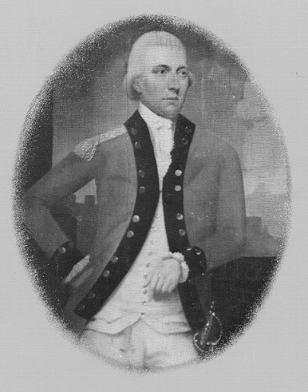
James DeLancey
Early
Manhattan Island
Westchester
Chasseurs were feared
in New York’s Westchester County as “DeLancey’s
Cow-boys”—a name inspired by the Chasseurs’cattle
rustling. They specialized in raiding
small villages and looting unarmed Rebels. A typical raid was
reported in the pro-Tory New York Gazette
on October 16, 1777: “Last Sunday Colonel James DeLancey, with
sixty of his Westchester Light Horse went from Kingsbridge to the
White Plains, where they took from the rebels, 44 barrels of flour,
and two ox teams, near 100 head of black cattle, and 300 fat sheep
and hogs.” General George Washington, in a report on the
Chasseurs, wrote in a report to Congress on May 17, 1781: “Surprise
near Croton River by 60 Horse and 200 Foot under Colonel James
DeLancey ... 44 killed, wounded and missing ... attempted to cut him
off but he got away.”.
DeLancey sailed for England in June
1783 and stayed there until he left for Canada, where he settled and
became a member of the legislature.
North
Carolina Loyalist Military Units
The initial name of the
first Loyalist military unit, North Carolina Provincials, was
bestowed in 1776 by the royal governor, Dublin-born Josiah Martin.
The commander of the Provincials, Brigadier
General Donald McDonald, was also a major in the Royal
Highland Emigrants, as were some of the officers and men in the
Provincials. Ever since, the two units have been entwined in accounts
of Tory military activities in the state. The Provincials had 1,200
to 1,400 men, including Highlanders, riflemen, and cavalrymen. In
February 1776 the Highlanders and others in the unit were defeated at
Moore’s Creek Bridge. Diminished by casualties and captures,
the Provincials ceased to exist as fighting force. About 100 North
Carolina militia men are believed to have been part of Ferguson's
doomed army at King’s Mountain.
Fanning's
North Carolina Loyalist Militia was
raised by David Fanning, who had lived in
both North Carolina and South Carolina and had served in both
Loyalist and Rebel militias. (See also King’s
American Regiment.)
From a fortified base at Cox’s Mill on the Deep River in
Randolph County he recruited Tories, skirmished with Rebel militias,
and scouted for General Cornwallis’s army. In
July 1781 he received a commission as a provincial colonel in command
of all Loyalist forces in Randolph, Chatham, Orange, Cumberland, and
Anson Counties. He soon was recruiting men for militias in Randolph
and Chatham Counties. Units
raised by Fanning fought 36 skirmishes and battles. In a raid in
Chatham County, his men broke up courts-martial of Tories, freeing 53
prisoners, and taking captive members of the General Assembly,
militia officers, and court officials. Fanning’s men, grown to
a force of more than 1,000, attacked the temporary state capital at
Hillsborough and captured the governor, his council, and many
government workers. After the British evacuation of Wilmington,
Fanning attempted to arrange a pardon for himself. But when an Act of
Pardon and Oblivion was passed in 1783, Fanning was one of three men
purposely left out. In
January 1782, after his futile negotiations for a pardon, he fled
North Carolina and by the close of the war had settled in Canada.
North
Carolina Highlanders was
the name given North
Carolinians who were sent to New York in 1782 and transported to St.
Augustine, Florida in 1783. North Carolina
Volunteers merged into the unit in 1783,
which disbanded in Canada in 1783. The North
Carolina Independent Company was attached to
the New York Volunteers
around August 1783 and later was dissolved.
North
Carolina Independent Dragoons, a cavalry unit
also known as Wilmington Light Dragoons, and
North Carolina Light Dragoons, was
raised at Wilmington,
North Carolina, and given uniforms purchased by their captain, John
Gordon. His successor, Robert Gillies, was killed
in a skirmish near Charlestown, South Carolina, on August 29, 1782.
Shortly later, the troop was dissolved and the effective men were
drafted into the South
Carolina Royalists.
Reid’s
Independent North Carolina Company
Following
the crushing defeat of a Loyalist force at Moore’s Creek Bridge
in February 1776, North Carolina Governor Josiah Martin formed some
of the survivors into an independent company. The commander was
Thomas McDonald Reid. The unit was disbanded around the end of 1776.
Royal
North Carolina Regiment was raised in New
York in 1777 by John Hamilton, a Carolinian who
fled the Rebels in his home state. He received the rank of captain
and was sent to Augusta, Georgia, to command North Carolina Tory
refugees there. Promoted to major and then lieutenant colonel, he led
the unit in the sieges of Savannah and Charlestown and in the battles
of Hanging Rock and Camden. The unit, down to two companies at the
time of the siege of Yorktown, was disbanded in 1782.
Oct
Royal
Volunteers of North Carolina, formed into a
company of foot and one of horse, began with the recruitment of
North Carolina Loyalist refugees in Georgia.
At some point between February and October 1779, the corps, by then
known as the Royal North Carolina Regiment, consisted of two
battalions.
Nova Scotia Militia
The militia did not play an important
role in the Revolution because its members were not trusted by
Canadian officials. In August 1775, Lieutenant
Governor Michael Francklin wrote to Lieutenant General Thomas Gage,
commander of British forces in North America, saying that expecting
Nova Scotia’s militiamen to repel an
invasion of the province would be like “trusting a Broken
Reed.” The Rebels, he wrote, “have already given out
they mean not to injure or molest those who are sons of liberty and
that have had no hand in assisting the Kings troops….”
So many militia men fit those categories that invaders undoubtedly
would find more friends than foes in Nova Scotia. The militia
remained essentially unused during the war.
Nova Scotia
Volunteers, raised by Nova Scotia Governor
Francis Legge, served mainly on garrison duty in the Halifax
area and was disbanded 1783.
Pennsylvania
Loyalists
William Allen raised
the unit in October 1777. Allen, from a prominent Pennsylvania
family, was one of the first officers
commissioned by the Continental Congress and took part in the
Continental Army’s invasion of Canada in 1775. But when
Congress declared independence, he resigned his commission and, as a
Loyalist lieutenant colonel, raised and commanded the Pennsylvania
Loyalists. In July 1778 the Pennsylvania Loyalists were
transported to New York and later to Halifax, Jamaica, and Pensacola,
Florida, where in December 1779 the unit was merged with Maryland
Loyalists. When Pensacola fell to the Spanish, the Loyalists were
sent to Havana as prisoners. They were repatriated to New York and
officially exchanged in July 1782. After the war, they sailed to
Halifax, where the unit was disbanded in October 1783. Allen exiled
himself in England. See also United Corps of Pennsylvania and
Maryland Loyalists.
Pepperell’s
Corps
Sir William Pepperell,
who raised and commanded this corps, lived in Jamaica Plains, outside
of Boston. After fleeing an anti-Loyalist mob, he enrolled “in
an association for the defense” but did not take up arms. He
departed for England in 1775 and became president of a Loyalist
association there. He was so respected in exile that he appears next
to William Franklin as a leading Loyalist in the Benjamin West
painting, The Reception of the American Loyalists by Great Britain
(which is used on the book jacket of Tories). Because he
never returned to America, Pepperell did not play any direct role in
the unit bearing his name. The members of his corps appeared to be
irregulars known as Associators. They received
no pay, and often did not wear uniforms; some earned a living by
looting. Rebels confiscated Pepperell’s vast holdings,
including an estate in Maine that ran from Kittery to Saco and
“many miles back from the seashore.”
Pfister’s
Corps of Royalists
Lieutenant
[later Colonel] Francis Pfister recruited 318 men from Rensselaer,
New York and Pownal, Vermont, a town profoundly split between
Rebels and Tories, most of who fled to Canada during the war.
Pfister’s men fought in Hoosick Falls (Walloomsac), New York
alongside Hessian troops in 1777 in a fight that was an offshoot of
the battle of Bennington. Pfister’s
father-in-law, a survivor, reported that 106
men were killed or taken prisoner. Survivors were put under
the command of Captain Samuel Mackay, who gave his name to the corps,
and then to Captain Robert Leake, who did the same. In November 1781
the unit was absorbed into the King's Royal Rangers of New York.
Philadelphia Light
Dragoons
When this mounted unit
was raised in Philadelphia, it consisted of two troops, one commanded
by Captain Richard Hovenden of
Bucks County, the
other by Captain Jacob James of Chester County.
Apparently the dragoons were dissolved as an independent unit when
the British evacuated the city. Either the entire unit—or
former members of it—were first attached to the British
Legion (also known as Tarleton Rangers) and the Queen’s
Rangers. Then, in 1782, the dragoons were incorporated into the
King's American's Dragoons.
Prince of Wales
American Volunteers
The unit had an unusual
origin: It was raised by Montfort
Browne, the Governor
General of the
Bahamas, who had been captured by Continental Navy sailors in
March 1776 on the island of New Province. Browne was a
prisoner in Connecticut when he began the regiment, which he would
command.
New recruits
were continuously enlisted to replace original
enlistees called “non-effectives.” At the muster of
November 15, 1779, for example, the number of men in the corps was
supposedly 613, but of these 74 were dead, 19 were prisoners, 25 had
taken their discharge, 30 had been transferred, probably as recruits
to the British Army, and 113 were deserters. The unit was sent to the
Bahamas, then to Charlestown in April 1779 and fought at Hanging
Rock, South Carolina. In June 1783 the unit returned to New York.
Provincial Light
Infantry was a New York unit that mustered nearly 200 men. One of
its commanders was Major Thomas Barclay, son of the rector of Trinity
Church in New York City. His Loyalist military career began when he
was a captain in the Loyal American Regiment and a leader of
the force that captured two Rebel forts on the Hudson River. In 1780
he took command of the newly formed Provincial Light Infantry, which
fought in battles and raids in New York, New Jersey, and the
Carolinas. At the end of the war he was one the senior officers sent
to Canada to find land for the settlement of Loyalist troops.
Quebec City Militia
Canadian Loyalists
reflected the situation in America: some supported the Revolution
(and would gladly become the 14th colony) and others, the Loyalists,
wanted Canada to remain under the king. In Quebec, the issue was
fought out in battles during the American invasion of 1775-1776, when
American troops—aided by pro-Revolution Canadians—attacked
the city. Canadian Loyalists joined the militia, the core of a
diverse defense force that included a French
Loyalist Regiment under Lieutenant Colonel Noel Voyer, a Royal Navy
Battalion, made up of sailors from warships and merchantmen; Loyalist
Captain Antony Vialars commanding an Independent Company; the
Loyalist Montreal Militia Regiment
deployed to Quebec under Colonel
Dufils Desaunior, and a
Militia Regiment under Lieutenant Colonel Henry Caldwell. He was a
leading citizen who was well motivated to join the militia.
Caldwell's house at Sainte-Foy had been taken over as the
Rebels’ headquarters and was later burned, along with all its
contents—and his mills were pillaged. After the battle,
Caldwell carried the dispatches reporting the victory to London. When
he returned, he was a leader in the plan to offer land grants to
settle Loyalists in Canada.
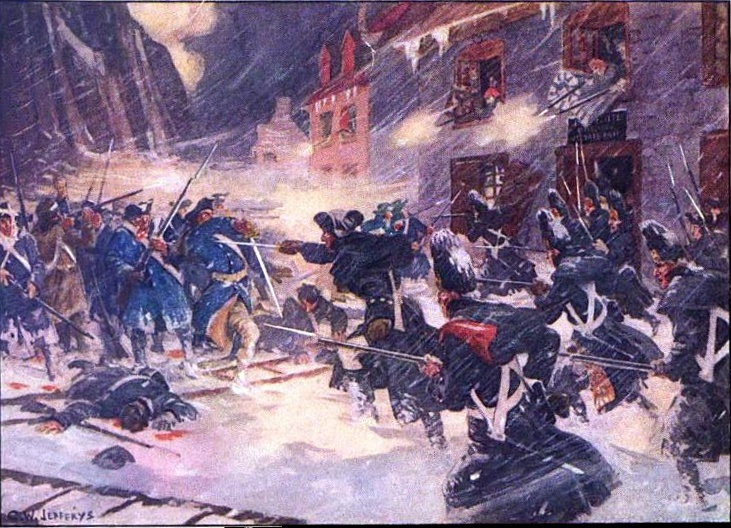
Canadian
militiamen and British soldiers repulse the American assault in the
battle of Quebec.
Painting by C. W. Jefferys.
Queen’s
American Rangers (also known as the 1st American Regiment)
The unit (named in
honor of Queen Charlotte, the wife of King George III) was raised in
August 1776 by Robert Rogers, who later was to raise the King’s
American Rangers. First mustered on Staten Island, the
Queen’s Rangers fought in many skirmishes. One of its costliest
encounters came in October 1776 when a Continental Army force made a
surprise night attack at Mamaroneck, New York, killing or wounding
about 20 Rangers and capturing about 30. In January 1777 Rogers was
removed from command and replaced by a series of British Army
officers. In October 1777, after the Rangers suffered heavy losses
at the battle of Germantown, Major John Graves Simcoe of the British
Army took command, sending the Rangers out on patrols and foraging
expeditions around Philadelphia. When the British withdrew from
Philadelphia in June 1778, the unit formed the rear guard and fought
in the battle of Monmouth Court House. Simcoe sent the Rangers off on
raids in New Jersey and was captured himself in October 1779. He was
exchanged in January 1780 and oversaw the Rangers’ final combat
in the South, ending with the Yorktown surrender in October 1781. The
regiment was officially disbanded in Canada in October 1783. Simcoe
became the first Lieutenant Governor of Upper Canada. The modern
Queen’s York Rangers of the Canadian Militia descends directly
from this unit, and is still sometimes styled the 1st American
Regiment. The unit had the honor of being placed on the British
Establishment.
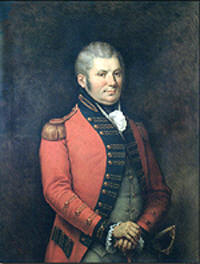
John Graves Simcoe
Queen’s Loyal
Rangers
General John Burgoyne,
preparing for his invasion of New York, made John Peters of Vermont a
lieutenant colonel and told him to raise a regiment. It was
officially known as the Queen’s Loyal Rangers and unofficially
as Peters’ Corps. More than 600 men served in the regiment,
which was assigned to the advance corps, leading the invasion forces.
They fought in battles from Fort Ticonderoga to Saratoga. Some 90
survivors made their way to Canada, where they were amalgamated with
survivors of the King’s Loyal Americans and McAlpin’s
Corps. The Rangers often crossed the border into New York and
Vermont, raiding Rebel settlements and gathering intelligence from
frontier Tories.
Queen’s Own
Loyal Virginia Regiment
Jacob
Ellegood, Virginia-born owner of two plantations, raised the regiment
in November 1775. Members of the regiment were among the
forces defeated by the Rebels in a crucial victory at Great Bridge,
near Norfolk, in August 1776. The regiment apparently disbanded
around the time that the British evacuated the Norfolk area.
Queen’s Royal
Rangers
Unlike the royal
governors in New England, the governor of Virginia, John Murray, the
Earl of Dunmore, decided to fight the Rebels in his state. In
November 1775, Dunmore formed a regiment he called the Queen’s
Royal Rangers, to be raised by enlisting Tories and Indians “in
the back parts and Canada.” For his new regiment’s
commander, he chose John Connolly and made him a lieutenant colonel.
Connolly, a nephew of a British Indian agent, lived in what had been
Fort Pitt (future site of Pittsburgh and, for a while, dubbed Fort
Dunmore). The governor believed that an expedition by the Rangers
would conquer the western territory, which Dunmore envisioned as a
future addition to Virginia. But within days after creation of the
regiment, Rebels arrested Connolly in Hagerstown, Maryland, on his
way to Detroit. He carried incriminating documents showing what
Dunmore planned. Connolly was imprisoned and released on condition
that he agreed to sail to England. There, he wrote a book
exaggerating his travail as a prisoner.
Roman Catholic
Volunteers
At a time when
Catholics could not join the British Army, this unit put them under
arms on the Loyalist side. The unit consisted of Catholics from
Delaware, Maryland, and Pennsylvania, many of them Irish deserters
from Rebel militias and the Continental Army. The men were called
“Papists” and viewed with suspicion because some British
officers wondered if they would fight against French Catholics. The
unit was formed in British-occupied Philadelphia in 1777 by Alfred
Clifton, described as “an English gentleman of an Irish
mother,” He was given the usual commander rank of lieutenant
colonel. Many of the unit’s members deserted or
were court-martialed for disciplinary violations. When the unit was
disbanded around the end of 1778, its men were transferred to the
Volunteers of Ireland and the British Legion.
Royal American
Reformers
Rudolphus Ritzema, born
in Holland, began his Revolutionary War as an officer in the
Continental Army and fought in the battle of Quebec as a colonel.
But, under the shadow of disciplinary trouble, he deserted during or
after the battle
of White Plains, joined the British Army,
and proposed the raising the Royal American Reformers. Its officers
were to be former Rebel officers who gave “some Proofs of the
Sincerity of their Repentance and are otherwise of an unblemished
Character.” In May 1778, as a lieutenant colonel, he raised a
few companies. In December 1778, the men were either demobilized or
reassigned, probably to the British Legion and DeLancey’s
Brigade, and Ritzema was retired.
Royal Fencible
Americans also known as the H.M. Royal Fencible American
Regiment of Foot
The term fencible
(“in defense of”) means that the unit can be deployed
only on home territory. When the unit was raised in Nova Scotia,
recruits came from there and from Newfoundland, St. John’s
Island (now Prince Edward Island), and the Boston area. After initial
service in Halifax, the unit was sent to Fort Cumberland on the Bay
of Fundy under the command of Lieutenant
Colonel Joseph Goreham, a former British Army officer. In
November 1776 the fort was the target of Jonathan Eddy, a former Nova
Scotia resident determined to invade his homeland and make it a Rebel
state. He appeared before the fort under a flag of true, with a force
of about 180 men, including Indians, Acadian exiles, and Rebels from
Maine. Eddy demanded surrender as “Commanding Officer of the
United Forces.” His five-week siege ended when British
reinforcements arrived and, with the Fencibles, drove off the
besiegers. In the winter of 1780 the Fencibles were recalled to
Halifax, making the 360-mile march on snowshoes. The unit was
disbanded in 1783.
Royal Highland
Emigrants, (also known as the 84th Regiment of Foot and
Young Royal Highlanders)
1st
Battalion: Lieutenant
Colonel Allan Maclean, born in Scotland,
began his military
career as a 17-year-old lieutenant in the Scots Brigade of the Dutch
Army. He fought in the Jacobite Rebellion of 1745 in support of
Charles Edward Stewart—Bonnie Prince
Charlie. He later served in the British Army and
was wounded in two battles of the French and Indian War. In 1775,
General Thomas Gage, commander in
chief of the British forces in North America,
authorized Maclean to raise a regiment from Scottish communities in
Canada, New York and the Carolinas. Recruits included many recently
arrived emigrants and former Highland soldiers who had settled in
Canada and America. Maclean’s finest hour as a commander of
Loyalists came when he fought in the battle of Quebec.
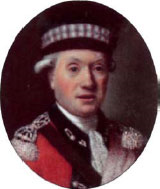
Alan Maclean
2nd Battalion: Raised in
June 1775, it was basically a Canadian defense force under Lieutenant
Colonel John Small, a British Army officer who had been wounded at
Bunker Hill. Some men were sent to
Fort Cumberland, a key Nova Scotia redoubt in July 1777. Detachments
were also posted at Windsor, Cornwallis, Annapolis, and along the St.
John River. Five companies sent to South Carolina fought in a bloody
battle at Eutaw Springs in September 1781, when British forces
clashed in what would be the last major encounter in the South. Sent
to New York in April 1782, the unit was ordered to disband in October
1783 but did not do so until 1784.
Royal North British
Volunteers
An early Loyalist unit,
it was raised in October 1775 in Boston by Scot merchants and led by
one of them, James Anderson, as captain,. Like many Boston Tories,
they were employed by the British as a police force. Their duty
stations included an alarm post near Fanuel Hall. They were ordered
to “Patrole the Streets within a certain District” and
“take into Custody all Suspicious & Disorderly Persons
found in the Streets at improper Hours.”
Saint
John’s Volunteers
When American
privateers raided Charlottetown, capital of St. John's Island
(present-day Prince Edward Island) in 1775, the island had no
garrison to defend it. The privateers kidnapped Attorney General
Phillips Callbeck and another official, along with the royal seal.
The officials—but not the seal—were returned a few months
later. In March 1776 Callbeck raised a garrison of 110 men and became
its captain. (A Volunteers commissary document, dated November 21,
1777, gives posterity an idea how much food 110 soldiers would need
for a year in those days: 22,000 pounds of pork, 40,000 pounds of
flour or bread, 1,800 gallons of peas, and 1,800 pounds of butter.)
In September 1779, fearing an attack on Quebec, the British ordered a
Hessian regiment to Canada. A storm struck the ships carrying the
Hessians, some of whom found temporary refuge on the island,
augmenting its garrison. The unit was disbanded in October 1783. For
his service as commander, Callbeck was granted 20,000 acres on the
island and his men received 100 to 500 acres each, depending upon
their ranks. This was a typical reward arrangement for former Tory
soldiers who chose to settle in Canada.
South
Carolina Loyalist Military Units
More than 6,000 South
Carolinians “performed loyal acts, either directly or by
association” during the Revolution, according to an exhaustive
study by Robert Stansbury Lambert, a South Carolina historian. And,
he estimates, about 3,900 men—many of them newcomers from
England, Scotland, and Virginia—joined Tory military units.
(Other estimates put the number at 5,000.) The state was a
battlefield. More than 130 battles and skirmishes were fought in
South Carolina, and, in many of them, Tories fought alongside
Redcoats and Hessians.
South
Carolina Light Dragoons of about 60 Hessian
soldiers was raised in Charleston in April 1781,
under Captain Freidrich Starckloff. The British gave the Hessians
provincial status. The unit was dissolved in 1782. Another unit,
raised by South Carolinians, was raised late in 1781 and dissolved
soon after two captains and one trooper were killed in a skirmish at
Fair Lawn Plantation
on August 29, 1782.
South
Carolina Militia was expanded by
General Henry Clinton in May
1780 when he ordered British Army Major Patrick Ferguson, Inspector
of Militia, to form “Companies consisting of, from 50 to 100
Men each, and will when the local and other Circumstances will admit
of it, form Battalions consisting of, from 6 to 12 Companies each,
allowing such as cannot conveniently be assembled in Battalions, to
remain as Independent Companies.” In 1781, when British troops
evacuated the state’s interior, militia regiments took over
occupation. Troops of cavalry became better regulated and
disciplined, smaller regiments were merged into large units. During
the war, by some estimates, about 5,000 men served the South Carolina
Militia—many first as Rebels and then as Tories.
South
Carolina Rangers, envisioned as
a unit of
500 men, was authorized in June 1780 and raised
by Major John Harrison, a Tory who earlier had spied for the British.
Probably no more than 100 men were enlisted. They were originally
stationed at Camden.
South
Carolina Royalists. The 1st
Battalion was raised in
May 1778 by Lieutenant Colonel
Alexander Innes and stationed at
Savannah from about November 1779. Innis was badly wounded in a
skirmish at Musgrove's Mill in August
1780. The unit fought often against Francis Marion, the Swamp Fox.
The unit, which had black troops, was evacuated to St. Augustine,
Florida, in November 1782. In October 1783, the white soldiers were
transported to Nova Scotia and disbanded. Black troops were
transported to West Indies and kept in service. Meanwhile, the 2nd
Battalion was raised in
East Florida in May 1778 under Lieutenant
Colonel Evan McLaurin, who had been imprisoned as a Tory leader in
South Carolina and escaped to East Florida. The battalion, consisting
of two troops of rifle dragoons and
four companies of infantry, was sent to Savannah in August 1779 and
to Charleston in May 1780, fighting in battle at Ninety-Six,
Hobkirk’s Hill, Eutaw Springs, and Waldboo Plantation. The
battalion was dissolved after being transported to New York in
November 1782.
Stewart’s
Troop of Light Dragoons
Originally a 12-man
unit of Tory express riders and guides, the troop was formed in July
1777 on Staten Island. The unit, which skirmished in New Jersey under
Captain William Stewart, was
later increased to 25 men, then reduced to 18, and finally melded
into the King’s American Dragoons.
Turks Island Company
One of many West Indian
units manned by Loyalists, this unit was put under the command of
Captain Andrew Symmer, who had been the king’s agent for Turks
Island since the 1760s. The island’s only industry was the
gathering salt, mostly for the American market, by slaves. Despite
the presence of the small Tory force, a black market in salt for
America continued throughout the war. After the
war, Turks Island was many of the Caribbean refuges that attracted
Tories, who became cotton planters.
United Corps of
Pennsylvania and Maryland Loyalists
This joint corps was
raised at Pensacola, capital of British West Florida, in December
1779. Learning that Spain had entered the war,
Don Galvez, the governor and military commander of Spain’s
Louisiana colony (after whom Galveston, Texas, is named), began a
conquest of the British West Florida colony. Defenders included
Maryland and Pennsylvania Loyalists, formed into the corps, which
mustered about 350 men. Spanish invaders—among them a few
Rebels—took several British outposts, including Mobile, in
1780. Pensacola was next. The outnumbered British-Loyalist force
fought bravely until, overwhelmed, they surrendered in May 1781. All
of West Florida became Spain’s. More than 1,000 British and
Loyalist troops were placed on a one-year parole on British-occupied
Long Island. In 1783 the unit was disbanded and 51 officers and men,
with 12 women, 11 children, and 6 servants sailed to Canada, where
they were granted land for settlement.
Van Alstine’s
Batteaux Company
A unit of about 250
Loyalists, the company was formed to transport the wounded from the
battle of Saratoga to Canada. The unit was commanded by Captain
Peter Van Alstine, a farmer of Dutch ancestry born in
Kinderhook, New York. Loyalists expecting to enjoy the rewards of
victory, marched off with Burgoyne when he invaded New York. After
defeat, they knew could not safely return to their homes. So many
headed for Canada; for the wounded, that meant Van Alstine’s
batteux. Van Alstine later led Loyalists and Quakers to the first
permanent white settlement at a new Ontario community called
Adolphustown for a son of George III.
Virginia Horse
Major John
Randolph Grymes raised this small cavalry unit in July 1776 for Royal
Governor Lord Dunmore and his Virginia Loyalists, who had been driven
from Norfolk to Gwynn’s Island in
Chesapeake Bay. When Dunmore was forced to evacuate the island,
Grymes accompanied him and in September 1776 became executive officer
of the Queens American Rangers, then commanded by Lieutenant
Colonel Robert Rogers. Wounded at battle of Brandywine, Grymes later
went to England, where he was agent for
prosecuting the claims of Virginia Tories.
Finally, he returned to
Virginia, settling in Orange County, where he bought land and resumed
life as a plantation owner.
Volunteers of Ireland (also
known as the 2nd American Regiment)
This unit was raised in
Philadelphia in May 1778 from recruits and from soldiers drafted from
other Loyalist regiments, principally the Roman Catholic
Volunteers and the New Jersey Volunteers. In July 1778 the
unit was sent to New York and named the 2nd American Regiment. But
they retained their original identity, which can be seen in a New
York newspaper reporting that the 400-man unit celebrated St.
Patrick’s Day “with their
accustomed Hilarity.” They were under the command of a
brilliant British Army officer and nobleman, Colonel Francis,
Lord Rawdon, as he preferred to be known.
A few weeks later, the Volunteers were in South Carolina and
fighting battles there through to late 1782, when they returned to
New York. The unit was disbanded and its veterans were sent to Tory
units in Charlestown, particularly the Prince of Wales American
Regiment, New Jersey Volunteers and DeLancey’s Brigade.
Volunteers of New
England
After a short
existence, with a maximum strength of only 32 men, the unit was
drafted into the King’s American Dragoons. The
commander, Lieutenant Colonel
Joshua Upham, was originally a
member of the Massachusetts Tory elite. He left his native state to
join the Loyalists in New York and became an
officer in William Franklin’s notorious guerrilla force,
Associated Loyalists, and took command
of Fort Franklin at Lloyd’s Neck, Long Island.
Onetime aide de camp to commander in chief Sir Guy
Carleton, Upham joined Carleton in London in 1783 and became a
lobbyist for the partitioning of Nova Scotia to created New
Brunswick as a Loyalist province. When that happened in 1784, he was
appointed a judge of the new province’s
Supreme Court.
Ward’s Company
of Refugees
Ebenezer Ward of Essex
County, New Jersey, formed this unit, which saw action as a guerrilla
force at Bergen Neck in February 1780 and at Newark in July 1780.
Ward’s name appears on a list of Tories whose property was
confiscated. A curious entry in The Book of Negroes lists
“Eliza Ward, 7, fine girl, (Ebenezer Ward).” The book
contains the names of black Loyalists and their families who sailed
to Canada in 1783 to settle on land granted to them for their service
in the war. Names in parentheses indicate who owned the black
Loyalists when they were slaves.
----
Units for which
little or no information is available, and units not directly
involved in military actions connected to the Revolutionary War.
Anderson’s
Independent Company of Volunteers
Bermuda Militia
Boston Regiment,
Massachusetts Militia
Brownjohn’s
Independent Company of Volunteers
Charlestown Militia,
1st Battalion,
Charlestown Militia,
2nd Battalion,
Chiltas’ Independent Company
of Volunteers
Collett’s
Independent Company of Provincials
Detroit Militia
Detroit Volunteers
Dickson’s
Independent Company of Volunteers
East Florida Militia
Light Horse
Georgia Rangers
Georgia Rifle
Dragoons
German Independent
Company of New York Militia
Golding’s
Company of Volunteers
Grenada Militia
Hatfield’s
Company of Partisans
Hazard’s Corps
of Refugees
Jamaica Militia
(Horse)
Jamaica Militia
(Infantry)
Loyal Commissariat
Volunteers
Loyal Ordnance
Volunteers
Massachusetts
Volunteers
McDonald’s
Company of Volunteers
Montreal Regiment,
Quebec Militia
New Jersey
Volunteers Light Dragoons
New York City
Militia
New York Independent
Highland Volunteers
Norfolk Regiment,
Virginia Militia
Robins’
Company of Partisans
Royal Georgia
Volunteers
Saint John’s
Parish Volunteers
Sharp’s
Refugee Marines
Smyth’s
Independent Company of Provincials
South Carolina
Independent Volunteers
South Carolina
Independent Light Dragoons
Skinner’s
Independent Company of Volunteers
Stanton’s
Company of Volunteers
Stewart’s
Company of Refugees
Taylor’s
Independent Company of Provincials
Templeton’s
Independent Company of Volunteers
Virginia Volunteers
West Florida
Independent Provincial Company
West Florida Militia
West Florida
Volunteers
Williams’
Independent Company of Volunteer
|
